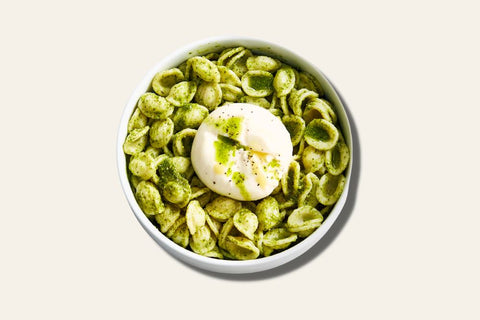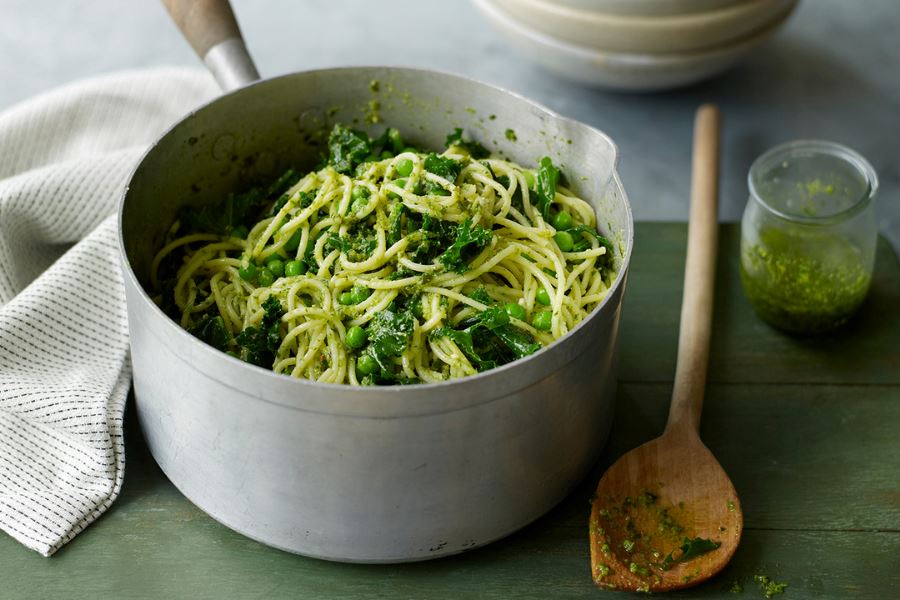When it comes to delicious foods, few things are as captivating as pesto pasta. This verdant elixir has been passed down through many generations from the sun-kissed Italian landscapes, and each sip is like a musical performance of flavors. Come along with us as we explore the fascinating background, materials, and techniques of making pesto, the green gold. In this blog by Burrata House, let’s talk about the vibrant soul of Italian Green Gold.
Unveiling the Vibrant Soul of Italian Green Gold – Pesto Pasta

A Gastronomic Adventure
The aromatic basil fields that meet the Mediterranean coast in the coastal region of Liguria are the origins of pesto. The ancient manner of producing this exquisite combination is reflected in the fact that the term “pesto” is derived from the Genoese word “pestâ,” meaning to pound or crush. A mortar and pestle were traditionally used to make pesto, which allowed the individual ingredients to release their flavor and blend in perfect harmony.
The Green Symphony
The flavorful essence of basil is vital to any pesto. The alluring scent of sweet basil is front and center in this herbaceous prelude. The flavors of the Mediterranean shine through in pesto, which combines pine nuts, garlic, Parmesan cheese, and a touch of extra virgin olive oil. Any dish fortunate enough to be graced with its verdant glow will be elevated by the burst of freshness created by the fusion of these ingredients.
Handcrafted Chemistry
Making pesto pasta recipe calls for both precision in measuring and a time-honored technique. To start, gather a handful of young basil leaves; the oils are strongest first thing in the morning. A handful of pine nuts will provide a touch of creaminess and a little crunch. Grate some Parmesan cheese for some savory depth, and crush a few garlic cloves to release their aromatic charm. To achieve the ideal consistency—not too thick nor too runny—of the green paste, slowly pour in extra virgin olive oil while the pestle and mortar do their thing.
A Plate of Versatility
The pesto’s adaptability is limitless. Traditional preparation calls for real pasta to make the famous “Pesto Pasta.” But this verdant nectar goes beyond pasta; it’s a staple in sandwiches, soups, and paninis as well. Add a splash of flavor to bruschetta or marinade grilled veggies with it. Pesto, the Italian Soul Food, can transform into any dish by just adding flavor and style.
Pesto: A New Take on Basil
Though basil is a major attraction, a rainbow of pesto varieties has been born from contemporary takes on the classic recipe. While sun-dried tomatoes bring a deep sweetness, the rocket adds a spicy kick. A subtle earthiness from the spinach and a new touch on the classic pine nut crunch from the pistachios make this dish very special. Pesto offers a limitless array of options, allowing food enthusiasts to create their unique flavor profile.
Pesto Pasta Recipes: A Delicate Harmony of Flavors
Mastering the art of pesto pairing calls for a nuanced knowledge of flavor complements. Make mealtime exciting with Delicious Pesto Pasta, and elevate your dining experience. Pairing pesto pasta with a crisp white wine, such as a Sauvignon Blanc or Pinot Grigio, can bring out the best in each flavor. If you like red wine, a delicate Chianti or Barbera will enhance the herbal aromas without being too heavy. Connoisseurs are encouraged to experiment with pesto to discover their ideal pairing.
Keeping the Past Safe in a Jar
The convenience of a food processor often takes the role of a mortar and pestle in today’s fast-paced world. The easily accessible jarred pesto from Italian shops brings a little bit of Italy to people’s kitchens all across the globe.These jars capture the spirit of summers in the Ligurian region, so even purists may enjoy a little bit of paradise with little work.
Final Thoughts
The emerald hues and harmonious flavors of pesto go beyond being just a delicious food; it embodies the Italian zest for life. A verdant ambassador, this green gold has gone global from the sun-kissed fields of Liguria to kitchens all over the world, bringing the lively spirit of Italian food to everyone. Let pesto pasta take you to a world of flavors, where every taste is a tribute to the diverse tapestry of Italian cuisine, whether you eat it in a classic trattoria or make it at home.
Frequently Asked Questions
Do most people prefer their pesto, hot or cold?
To produce pesto sauce, you need to cook fresh basil, which changes its chemical composition and makes it darker. Use it warm or at room temperature for the greatest results. You can thin it out with a little water, chicken stock, cream, or white wine if necessary.
How many servings of pesto pasta are there?
Pesto pasta can be stored in the fridge for up to four days if sealed tightly. If you have any leftovers, you can reheat them in the microwave or a skillet over medium-low heat.

